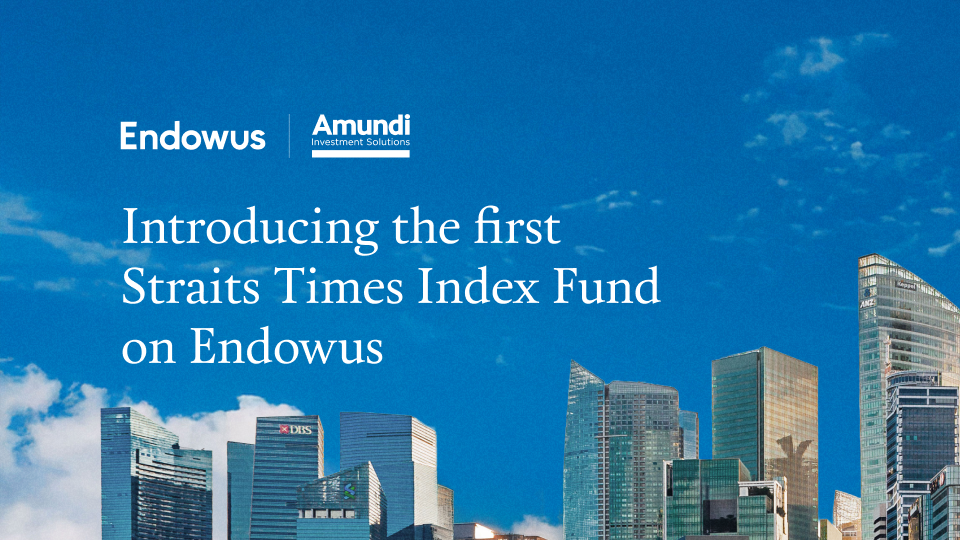Register for the event
Endowus invites you to our exclusive event with Macquarie Asset Management, as we discuss unlocking opportunities in Infrastructure- a $1.3tn asset class.
This event is reserved for Accredited Investors (AIs) only. To register for the event, please indicate one of the following:
- China's government announced a stimulus package aimed at boosting economic growth, stabilising the property market, and revitalising the stock markets.
- The announcement led to a surge in the stock market, with the Hang Seng Index and CSI 300 Index recording significant gains.
- Fund managers believe that the stimulus measures are more comprehensive and targeted compared to previous attempts, and there is a sense of urgency in addressing economic challenges.
- The success of the stimulus package will depend on policy implementation and improvements in economic data.
- External factors, such as geopolitical uncertainty and the US elections, could influence the duration of the market rally.
China’s pool of more than 200 million retail investors unwrapped their early National Day gift.
In a surprise move, China’s government announced on 24 Sep its latest bazooka stimulus aimed at boosting economic growth, stabilising the property market, and revitalising the stock markets.
A concerted effort was gathered from top financial regulators—the People’s Bank of China (PBOC), China Securities Regulatory Commission (CSRC), and the National Financial Regulatory Administration (NFRA).
What chiefly sent individual investors scurrying back to the domestic stock market was the liquidity support injected into it. Post announcement, the Hang Seng Index has since jumped 15%, and the CSI 300 Index, tracking onshore shares, recorded its biggest gain since July 2020, according to Bloomberg data.

A summary of the policy stimulus
Supporting the stock market
- The government announced RMB800 billion of liquidity support for the stock market.
- This is done through a swap facility for brokers and funds (of RMB500 billion), and a refinancing facility for companies and shareholders for stock buybacks (RMB300 billion).
Lowering interest rates
- The central bank cut key lending rates and its reserve requirement ratio (RRR)
Stabilising the property sector
- A 50 basis point cut to the existing mortgage rate, helping current homeowners save their loan repayments.
- Lowering the downpayment for the second home purchase from 25% to 15%, to be in line with the first home purchase
Wild swings in sentiment have foreshadowed plunges – after surges continued for days, the Hang Seng Index corrected slightly on Thursday 3 October.
Indeed, the rally was long-awaited and cheered by many, but it also raised alarms for some: the rapid pace of the rebound was unsettlingly reminiscent of the raging bull run a decade ago.
In 2015, the market was fueled by a government communication campaign designed to encourage citizens to invest in the market. Just within one and a half years, the Shanghai market rallied to nearly double in value – more than 38 million new investment accounts opened in the two months leading up to the bubble burst around mid-2015.
Would this decisive shift from debt control to growth support lead to a sustainable rally, or is it building up risks for another burst? We have our fund manager partners to unpack the implications for Endowus clients. They are Franklin Templeton Investments, Janus Henderson Investors, Matthews Asia, and JP Morgan Asset Management.
The excerpts are edited for clarity and brevity.
<divider><divider>
The high-profile commitment shows a willingness to pledge more reforms
This is an excerpt taken from a commentary by Franklin Templeton Investments published on 30 Sep 2024.
“The surge in China’s equity market after the announcement is based on investors’ hope that Chinese policy is making an important turn, one that while not sufficient has nevertheless improved China’s growth and earnings prospects relative to the previous status quo.
To emphasise, this is not yet a case of Beijing “having done whatever it takes.” But given the high-level personal credibility at stake, we believe it suggests a willingness to do much more in the months to come. China still needs to address growing the consumer market and building social safety reforms—like retirement and health care—to reduce the high savings rate. The work of the government is far from done
In our analysis, the Chinese equity market represents an intriguing value proposition. As value investors know, however, low multiples alone do not assure high returns. Cheap can remain cheap. In our view, what is instead required is a catalyst to shift investor attitudes from the justification of low multiples to the possibility of something better. We believe China’s high-profile commitment to buttress its economy is just that type of catalyst.”
<divider><divider>
Why is this round of stimulus different?
This is an excerpt taken from a commentary by Janus Henderson Investors published on 1 Oct 2024.
“Although previous attempts at stimulating China’s economy such as in April 2024, which saw the issuance of long-term special government bonds failing to create lasting momentum, there are compelling reasons why it may work this time round:
More supportive external environment
The US Federal Reserve’s rate cut in September has created a more favourable environment for Chinese policymakers to implement stimulus measures, reducing concerns about capital flight or currency devaluation.
Increased sense of urgency
The deterioration of China’s economic fundamentals, particularly the property market downturn and weakening consumption, has reached a point where policymakers see a need for decisive action. This urgency is evident in the off-schedule Politburo meeting, and the unusually direct language used in the policy statements.
More comprehensive and targeted measures
Unlike previous efforts, the measures address not just monetary policy, but also property sector challenges, stock market stability, and consumer confidence. Additional measures may also be announced in the coming weeks.”
<divider><divider>
Take a “wait and see” approach to gauge the success
This is an excerpt taken from a commentary by Matthews Asia published on 1 Oct 2024.
“Liquidity support for the stock market, coupled with a swap facility for brokers and funds and refinancing facility, is a facility via the PBOC for companies and major shareholders to borrow at a very cheap interest rate to allow them to buy back stock and we know that the stock market in China is very cheap.
There will also be upcoming measures from the China Securities Regulatory Commission (CSRC) aimed at encouraging mergers and acquisitions. Taken together the measures signal a clear intent to support the stock market, which has been underperforming.
In terms of the success of this package, we will have to wait and see. It would seem to us that the government is showing more determination to turn things around. For us, it is the broadest, most aggressive set of moves that we've seen in three and a half years.
We also believe that Chinese equities, despite all the macro negativity, have been priced too cheaply. We have seen earnings upgrades this year but they have not been reflected in stock market pricing. So we don't think drastic improvements in the economy are needed for the market to do quite well. Going forward, we believe a lot of these measures have the potential to aid China’s recovery and provide positive support to its equities.”
<divider><divider>
What can sustain the latest Chinese equity rally?
This is an excerpt taken from a commentary by JP Morgan Asset Management published on 1 Oct 2024.
“A sustained rally may require investors to view China as a strategic rather than a tactical investment. Any further upside will likely require details on policy implementation and an eventual improvement in economic data.
Good intentions will need to be followed by actions. Following the National Day holiday, as investors return to the market on 8 October, they may be looking for more details on how these policy announcements will be implemented.
The National Day tourism and consumption numbers could provide an early glimpse of this sentiment change, which could point towards some short-term improvement in discretionary spending. For the housing market, a high level of inventory and financial constraints with the developers implies it would still take several quarters before the sector could stabilise.
Overall, additional policy steps would be needed to boost economic activity and confidence. The policies announced so far can help to smoothen out the de-leveraging process, but the balance sheet repair would still need to take place.
External factors at play: Long-term real money investors
Beijing’s coordinated policies to support the economy are a positive step for the Chinese economy and its markets. As we wait for better economic data, it is important to remember that some external factors such as geopolitical uncertainty remain.
With the US elections only a month away, many investors would argue that the US view of China as an economic and geopolitical rival is a bipartisan consensus. However, details matter when it comes to policy implementation. Between former president Trump’s pledge of a 60% tariff on all Chinese exports, and perhaps a more targeted approach from Vice-President Harris, the impact on the Chinese and global economy could vary considerably.
Moreover, how international investors manage the potential geopolitical risks may influence the duration of the current market rally. For now, foreign investors may choose to wait for economic data to bottom out and for this new policy direct to solidify.
Buy-in from international long-term real money investors, when it comes, could add to the sustainability of the current rally in the Chinese stock market.”
Ride through volatilities with a diversified approach
China equities have rebounded strongly from multi-year lows and now have a positive year-to-date return. Just as no one could have predicted the multi-year downturn when markets fell more than 60% from the most recent peak in 2018, very few had timed the policy-driven rebound recently.
No one can predict the future direction of China’s market, other than to say that it will remain volatile. We should not be swayed by market volatility or chase markets up or down. The key is to diversify your risks by investing across asset classes and geographies and to only take calculated risks that you get compensated for with investment returns.
With Asia’s leading wealth management platform Endowus, you can plan and manage your money — by investing in Best-In-Class Funds and globally diversified, intelligent, low-cost funds and portfolios seamlessly.
Click here to get started with your investing journey with Endowus today.
Subject to individual investment objectives and risk tolerance, you can explore the Endowus China Equities satellite portfolio and 400+ Best-In-Class funds from leading global fund managers, across asset classes, sectors, and geographies (such as China, India, and the US) on the Endowus Fund Smart platform.









.webp)




%20(1).gif)

.jpg)




%20F1(2).webp)

.webp)






.webp)